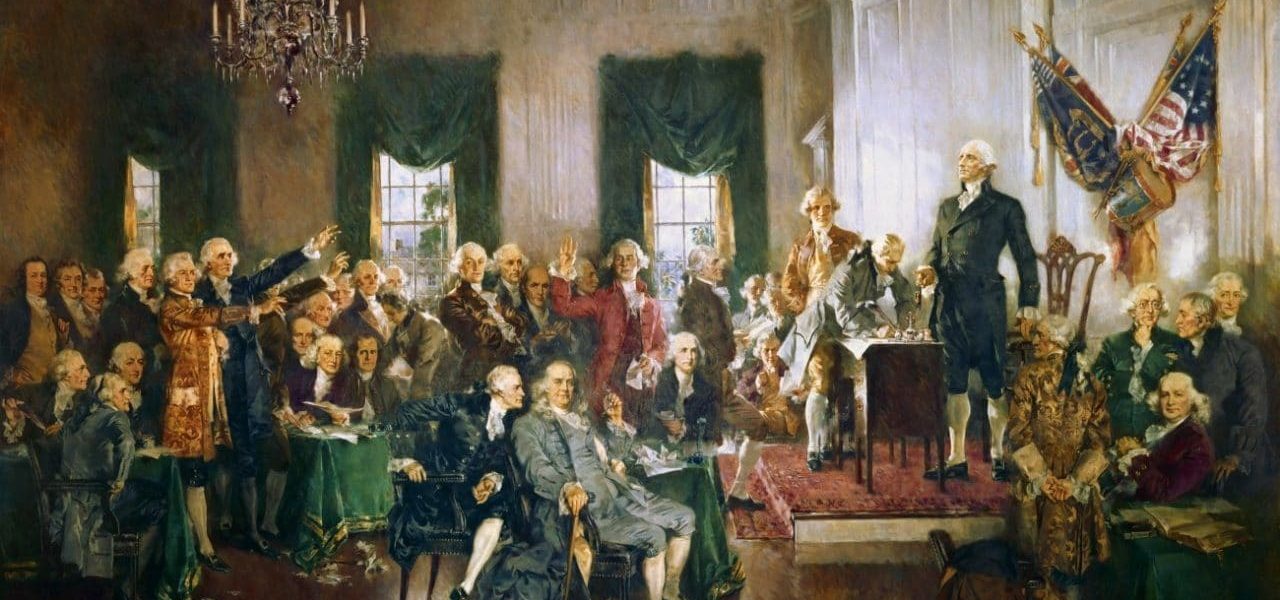The first weeks of July, 1787 were full of fiery speeches, threats of disunion, and tenuous compromises. In other words, just an ordinary time at the Constitutional Convention of 1787.
On July 16, 1787 after nearly two weeks of debate, the convention adopted what has come to be known as the “Great Compromise.” Essentially, the compromise established that representation in the House of Representatives would be decided according to population, while in the other chamber of the legislature — the Senate — each state would be represented equally.
That day was a Monday and as soon as delegates were seated, the final vote on the compromise was taken. The tally was razor thin: five votes in favor of the new scheme of representation, with four opposed. Massachusetts was undecided, and thus the proposal passed.
Had Massachusetts managed to side with the opposition (which seemed likely), the convention likely would have ended, delegates favoring equality already having signaled earlier in the month that if the vote went the way of the large states, they would walk out without joining with the other states in a new constitutional confederacy.
At the Maryland ratification convention, Luther Martin, a participant at the Philadelphia convention, reminded his colleagues that the convention was “on the verge of dissolution, scarce held together by the strength of a hair though the public papers were announcing our extreme unanimity.”
As one studies the record of the deliberations carried on that summer of 1787, he comes to realize just how thin that hair really was. Nowhere is its small gauge more evident than in the debates preceding the approval of the Great Compromise.
The vote came about as a result of the work of a committee selected earlier in July to hammer out some sort of compromise to the representation issue.
Historically, the Great Compromise has been called the “Connecticut Compromise,” in honor of Roger Sherman, delegate from that state, who is credited with coming up with the idea. While Sherman did serve on that committee, at the time there were those who identified a motion made by Benjamin Franklin in the committee’s meetings that led to the proposal that saved the Constitution. Either way, there is an essential element of Sherman’s support for the plan that has gone generally unnoticed by historians and history teachers.
Unlike many of the more notable names that are associated with the Constitutional Convention, Roger Sherman actually showed up almost every day debates were held (compare that to Alexander Hamilton’s near non-participation, and it’s a wonder why Sherman didn’t inspire a hit Broadway show!).
When it came to the question of how representation in the legislature should be determined, Sherman advocated the solution he supported in the Continental Congress during the drafting of the Articles of Confederation — bicameral composition with one house apportioned according to population.
As the story is told today, the Great Compromise is described as a victory for “small states,” when in reality, Sherman considered it a victory for the perpetuation of state sovereignty.
In his Notes of Debates in the Federal Convention of 1787, James Madison records that on Saturday, July 14, Roger Sherman “urged the equality of votes not so much as a security for the small states; as for the state governments which could not be preserved unless they were represented and had a negative in the general government.”
We see, then, that Sherman’s intent was not so much to save the convention as it was to save the sovereignty of the states whose interests were ostensibly being furthered by the work being done there.
James Madison, in a letter to Martin Van Buren written in 1828, recalled that the “threatening contest” at the convention was not so much on how much power the federal government should have, but on making sure that the states “were represented” and could legislatively control the acts of the “general government.”
Curiously, Madison also records that it was likely the failure of the representatives of the large states to agree on a plan to adopt whatever form of representation they favored given that they had a majority of votes in the convention that ultimately convinced the smaller states that “they had nothing to apprehend from a union of the larger in any plan whatever against the equality of votes in the Senate.”
In other words, gridlock saved the Constitution!
As for Sherman, he felt that the compromise was sufficient to protect the prerogatives enjoyed by sovereign states and accordingly he pushed for passage of the Constitution at the Connecticut ratifying convention.
In a letter to the Connecticut state legislature sent in September 1787 in which he included a copy of the Constitution, Sherman and fellow Connecticut delegate Oliver Ellsworth assured lawmakers from their home state that their authority was not abridged by the document they were transmitting to them.
“The equal representation of the states in the Senate, and the voice of that branch in the appointment of offices, will secure the rights of the lesser, as well as the greater states,” Sherman wrote.
Sherman went on to explain that while the federal government was given a few additional powers in the Constitution, there was no threat to state sovereignty.
“Some additional powers are vested in Congress, which was a principal object that the states had in view in appointing the Convention; those powers extend only to matters respecting the common interests of the Union and are specially defined, so that the particular states retain their Sovereignty in all other matters,” Sherman and Ellsworth wrote.
Earlier, on June 6, Sherman spoke in favor of a general government possessed only of a few, narrowly defined powers: “Some additional powers are vested in Congress, which was a principal object that the states had in view in appointing the Convention; those powers extend only to matters respecting the common interests of the Union and are specially defined, so that the particular states retain their Sovereignty in all other matters.”
Only a day after the Great Compromise was narrowly adopted by the Constitutional Convention, delegates were back to their bickering ways, this time on the question of just how much power the newly constituted Congress should have.
A particular motion by one of the delegates demonstrates the remarkable foresight one notable member of that august convention possessed.
On Tuesday, July 17, Gunning Bedford of Delaware proposed and Gouverneur Morris seconded a move to change the clause relating to the powers of Congress, to read thus: “To enjoy the legislative rights vested in Congress by the Confederation, and moreover to legislate in all cases for the general interests of the Union, and also in those to which the states are separately incompetent, or in which the harmony of the United States may be interrupted by the exercise of individual legislation.”
Upon hearing this, Edmund Randolph of Virginia — one of the delegates who ultimately did not endorse the Constitution — exclaimed, “This is a formidable idea indeed. It involves the power of violating all the laws and constitutions of the states and of intermeddling with their police.”
Despite Randolph’s warning, the motion passed by a vote of six to four. Note: the provision did not make it into the final version of the Constitution.
Finally, staying with the theme of the power to be given the federal government regarding its relationship with the states that created it, the delegates considered granting to the federal government the power to veto state laws.
During the debates, representatives from Massachusetts, Pennsylvania, and Virginia spoke in favor of this proposal. James Madison went so far as to praise the idea, describing it as “essential to the efficacy and security of the general government.”
Elbridge Gerry of Massachusetts, however, would have none of it. Earlier in the summer when the idea was first floated, Gerry declared that “a national legislature with such a power may enslave the states.”
Today, while we focus on the efforts of a few men and women to obtain the office of the presidency, let us recall the events of 228 years ago when the Constitution that created that office was narrowly saved by a compromise — a compromise intended by its sponsor to save the sovereignty of the states in the face of formidable federal power.
This article was originally published at The New American and is reposted here with permission from the author.








